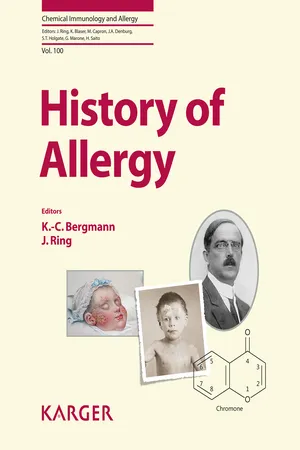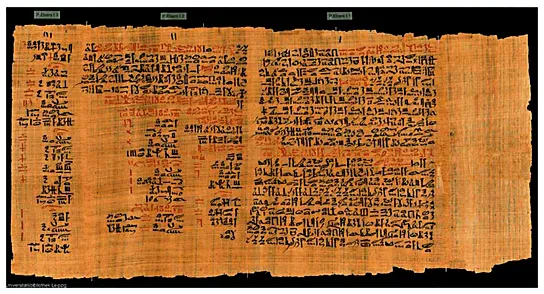
eBook - ePub
History of Allergy
- 446 pages
- English
- ePUB (mobile friendly)
- Available on iOS & Android
eBook - ePub
History of Allergy
About this book
The prevalence of allergic diseases has increased dramatically over recent decades, both in terms of the number of sufferers and the number of allergies. This is a trend that has frequently been referred to as "the epidemic of the 21st century". As described in ancient texts, allergies have been known for over 2,000 years, but the term "allergy" was only coined at the beginning of the 20th century when doctors began to understand their pathophysiological basis. This book presents a detailed and varied historical overview of the field of allergology. Beginning with insights on allergy from antiquity to the 20th century and the development of the associated terminology, it compiles historical reflections on the understanding of the most common allergic diseases. Important milestones in the discovery of mechanisms of allergy are described, followed by historical accounts of the detection of allergens such as pollen, dust mites, peanuts and latex, and of environmental influences such as pollution and the relationship between farmers and their environment. Several chapters illustrate the progress made in allergy management to date. Particular highlights of this book are the personal reflections of and interviews with a number of pioneers of allergy, including F. Austen, J. Bienenstock, K. Blaser, A. de Weck, A.W. Frankland, K. Ishizaka, and many more. Concluding with portrayals of allergy societies and collections, as well as being supplemented by two films, this book represents a veritable treasure trove of fascinating and richly illustrated information. Not only researchers, physicians and medical historians, but also students and even non-scientists will find History of Allergy a scientific adventure well worth reading. (A Karger "Publishing Highlights 1890–2015" title)
Frequently asked questions
Yes, you can cancel anytime from the Subscription tab in your account settings on the Perlego website. Your subscription will stay active until the end of your current billing period. Learn how to cancel your subscription.
No, books cannot be downloaded as external files, such as PDFs, for use outside of Perlego. However, you can download books within the Perlego app for offline reading on mobile or tablet. Learn more here.
Perlego offers two plans: Essential and Complete
- Essential is ideal for learners and professionals who enjoy exploring a wide range of subjects. Access the Essential Library with 800,000+ trusted titles and best-sellers across business, personal growth, and the humanities. Includes unlimited reading time and Standard Read Aloud voice.
- Complete: Perfect for advanced learners and researchers needing full, unrestricted access. Unlock 1.4M+ books across hundreds of subjects, including academic and specialized titles. The Complete Plan also includes advanced features like Premium Read Aloud and Research Assistant.
We are an online textbook subscription service, where you can get access to an entire online library for less than the price of a single book per month. With over 1 million books across 1000+ topics, we’ve got you covered! Learn more here.
Look out for the read-aloud symbol on your next book to see if you can listen to it. The read-aloud tool reads text aloud for you, highlighting the text as it is being read. You can pause it, speed it up and slow it down. Learn more here.
Yes! You can use the Perlego app on both iOS or Android devices to read anytime, anywhere — even offline. Perfect for commutes or when you’re on the go.
Please note we cannot support devices running on iOS 13 and Android 7 or earlier. Learn more about using the app.
Please note we cannot support devices running on iOS 13 and Android 7 or earlier. Learn more about using the app.
Yes, you can access History of Allergy by K. -C. Bergmann,J. Ring,K.-C., Bergmann,J., Ring, T. A. E. Platts-Mills,T.A.E., Platts-Mills in PDF and/or ePUB format, as well as other popular books in Medicina & Dermatologia. We have over one million books available in our catalogue for you to explore.
Information
1 Allergy through 20 Centuries
Allergy through 20 Centuries
Bergmann K-C, Ring J (eds): History of Allergy. Chem Immunol Allergy. Basel, Karger, 2014, vol 100, pp 2-14 DOI: 10.1159/000358422
History of Allergy in Antiquity
Johannes Ring
Department of Dermatology and Allergy Biederstein, Christine Kuehne Center for Allergy Research and Education (CK-CARE), Technical University of Munich, Munich, Germany
Abstract
Allergic diseases are not new. They have been described in the early medical literature in various cultures like Egypt, China, indigenous America and in the Greco-Roman tradition. The terms ‘idiosyncrasy’, ‘asthma’ and ‘eczema’ are still in use today. The most famous allergic individual of antiquity with the whole triad of atopic diseases and a positive family history of atopy probably was Emperor Octavianus Augustus.
© 2014 S. Karger AG, Basel
Today allergic diseases represent one of the major health problems in most countries of the world [1]. They are often regarded as typical diseases of civilization. The impression can be gained that these diseases did not exist in the past and have developed as totally new entities. In this article we want to show that – although probably much rarer – the actual symptoms and clinical conditions of allergic diseases already existed 2,000 years ago.
This is not a scientific historical investigation the analysis is difficult because there are no classical ‘publications’. The descriptions in the literature are often imprecise and we do not have photographs or pictures. However, from the description of symptoms as well as the information regarding therapeutic strategies, conclusions can be drawn with regard to suspected diseases.
This article is based on the excellent work of the chairman of the Institute for History of Medicine at the University of Düsseldorf, Prof. Dr. Dr. h.c. Hans Schadewaldt, who devoted his life to the history of allergy as well as other textbooks of medical history [2-5].
We will proceed by considering different cultural regions. In the following we briefly want to show which symptoms or diseases regarding allergy have been described in antiquity, which therapeutic regimens were used and, finally, whether there have been historically identified individuals who were affected by allergic diseases.
Mesopotamia
According to many authors the cradle of culture – at least of Western culture – was in the area between the rivers Euphrates and Tigris when the Sumer people formed cities. Health and disease in antiquity were often related to religion – physicians were often priests and disease was commonly regarded as a consequence of sin.
In Mesopotamia, three means of disease development were known:
– the direct influence of gods,
– the withdrawal of divine protection, and
– the effect of black magic.
Breathing also had a very special importance. On old cuneiform script tablets therapeutic recommendations against cough and dyspnea can be found. An example is given here:
When the patient suffers from cough, he should drink a mixture of Lolium and rose powder dissolved in oil and honey. Afterwards he should eat a broth of pork meat. When he has to defecate, a fire should be lighted where he should direct his anus. Then he will be cured. [2, vol. 1, p. 96]
Egypt
Similar to Mesopotamia, physicians and priests in Egypt were often the same. Medical knowledge was supposed to originate from the god Thoth and was collected for history by Imhotep around 2700 BC in the third dynasty (fig. 1). Sir William Osler called Imhotep the ‘first physician as a person which clearly appears in antiquity’ [5, p. 40]. The Greeks identified Thoth with their god Hermes, whom they called three times great ‘Trismegistos’. The books which contained his wisdom were known as the Hermetic Collection.
Although we do not know a lot about the teachings of Imhotep himself, he can be regarded as the first documented physician (fig. 1). Two or three centuries later we might have evidence for the first allergist, namely the Egyptian Sekhetnankh (Sekae-tenanch) who was treating nasal disease as the personal physician of Pharaoh Sahura of the 5th dynasty. We find Sekhetnankh and his wife in stone at the tomb of the Pharaoh with the inscription ‘he cured the noses of the kings’ [6]. The pyramid of Pharaoh Sahura is located in Abusir, around 17 km to the south of Cairo [7].
People in Egypt estimated tradition very highly and accepted the high authority of existing texts. So, although some documents date from later times (from the new kingdom after 1650 BC), one can assume that they originated in much earlier times.

Fig. 1. Imhotep, deified priest from Old Egypt.
One of the most important documents of medical literature in old Egypt is the Papyrus Ebers (17th dynasty, 1650-1652 BC; fig. 2) which was bought by the German Egyptologist Georg Ebers for the museum of the city of Leipzig [8]. The Papyrus Ebers is more than 20 m long and contains 108 columns of text. A lot of therapeutic regimens are described which can also be used for the treatment of asthma. Therefore, many researchers believe that asthma was known in Egypt. The Papyrus Ebers was found in 1862 near Theben, between the legs of a well-preserved mummy. It was known in antiquity and quoted in the 2nd century AD by St. Clemens from Alexandria, who described it as a collection of the worldly wisdom of the god Thoth.
A total of 21 prescriptions against cough or dyspnea can be found, 12 of which name honey, dates, inhalation of myrrh and incense, as well as onions, juniper and beer. Against a ‘running nose’, lavations with palm wine were recommended, as well as topical application of smashed dates. Ebbell [8], who was a rather liberal translator, used ‘asthma’ for some not well-described diseases that were translated by Joachim [9] as ‘major weakness’. Here is an original quotation:
Thou shalt take seven stones and heat them by the fire, thou shalt take one of them and place a little of these remedies on it and cover it with a new vessel the bottom of which is perforated and place a stalk of reed in this hole; thou shalt put thy mouth to this stalk, so that thou inhalest the smoke of it. Likewise with all stones. [5, p. 43; 8]

Fig. 2. Hieratic script from the Papyrus Ebers, in which remedies for asthma are described.
In a prayer of Nefer-Abu, another source for the description of asthmatic dyspnea can be found:
Day and night I was in her hand. I was sitting like a woman in labor on the birthing chair. I was gasping for air, it did not come to me. [10]
Indigenous Populations in America
Although there are few direct sources, we know of some remedies used by indigenous Indians from the reports of Spanish conquistadors and monks, and can draw conclusions with regard to several diseases. The so-called latex therapy was widely used where physicians used plasters of...
Table of contents
- Cover Page
- Front Matter
- 1 Allergy through 20 Centuries
- 2 Most Common Allergic Diseases: Historical Reflections in Understanding
- 3 Mechanisms of Allergy: Important Discoveries
- 4 Detection of Environmental Influences and Allergens
- 5 Progress in Allergy Management
- 6 Pioneers of Allergy: Personal Reflections
- 7 Allergy Societies and Collections
- 8 Online Supplementary Material
- List of Illustrations / Figure Credits
- Subject Index